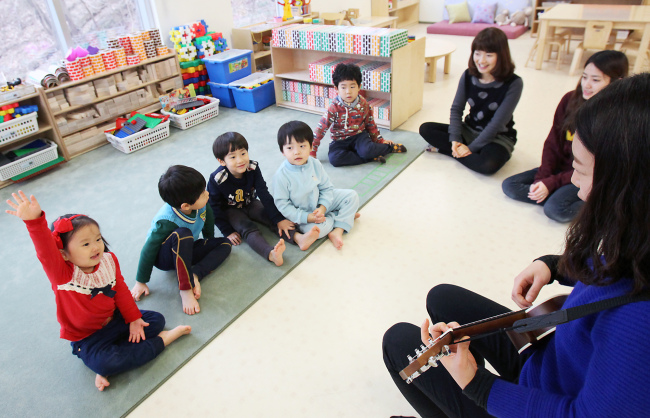[Voice] How can Korea provide better child care?
With balancing work and home life a struggle for many ...
By Korea HeraldPublished : Feb. 11, 2013 - 20:36
Before her election and since, President-elect Park Geun-hye has pledged to make child care a priority of her government.
On the campaign trail last summer, Park lamented that women, whom she called the “engine” for future growth of the country, were “abandoning their dreams” due to the lack of support for women to balance work and family life. To rectify this, Park promised to expand state support for home child care services, cover after-school child care expenses for all families and institute one month’s paid paternity leave.
On the campaign trail last summer, Park lamented that women, whom she called the “engine” for future growth of the country, were “abandoning their dreams” due to the lack of support for women to balance work and family life. To rectify this, Park promised to expand state support for home child care services, cover after-school child care expenses for all families and institute one month’s paid paternity leave.

Ineligibility
Park’s pledges have been part of a broader political drive to increase public spending on child care services, with the National Assembly in November passing a law to provide free day care to all children under age 5.
Many working parents whose children are ineligible for the scheme, however, still find the cost of child care and related services for their children while they are at work prohibitive.
“In total, I spend around 500,000 won per month on ajumma fees ― she comes four times a week, once to clean ― and another 200,000 won on the child care center,” said a media worker and mother of one in Seoul surnamed Kim, who also shells out for math, writing and taekwondo lessons.
“I won’t say how much this takes up in my household budget, but you can guess it’s a lot. I usually end up spending around 1 million won every month.”
On a typical day, Kim’s 6-year-old son is looked after at a state-funded child care center until 5 p.m., after which he attends taekwondo lessons. With Kim and her husband working well into the evening, it is up to her mother or the family nanny to pick up her son at 6:30 p.m. Kim and her husband typically spend about 1 million won every month on a state-funded child care center, nanny, and math, writing and taekwondo lessons.
“If they are not going to offer good child care at more affordable costs ― many moms can’t even get into the state-funded child care centers ― or cut the costs for ajummas ― live-in ajummas are paid up to 1.6 million won each month ― then at least, give me a lump sum of money each month to cover for some of these costs,” said Kim. “Then maybe I’ll consider having another child.”
Even for those families who have seen their child care costs come down, securing a place for their child at one of the country’s highly sought-after public centers can prove impossible.
“It is not easy to access public child care because only 5.3 percent of the total facilities are public,” said Kim Eun-seol, a research fellow at Korea Institute of Child Care and Education.
“Even though the legal rate for the fee is equally applied to both public and private child care facilities, private facilities ask additional charges for their extra activities. Parents believe the quality of child care service is also better in public centers because publics do not pursue profit.”
Standards
To ensure adequate standards, the government has implemented an accreditation system for child care centers since 2006, and also provides such facilities with a standardized curriculum. Despite this, some experts say that the qualifications of many child care providers are not up to par.
“There are many unqualified or low-qualified child-care givers in Korean child care institutions, because there are many short-term training centers for child-care giver certificates,” said Julie Lee, a professor at the Department of Child Welfare at Chung-Ang University.
Lee said that poor wages given to child care providers, who on average earn just over 1.2 million won a month, were a major factor behind the dearth of well-qualified child care workers.
“Well-qualified teachers are most important for child care in institutions. Thus, for this the government should increase the pay of child care teachers. Presently, child-care givers’ pay is very low. Many college students do not want to be child-care givers in child centers.”
It is not just economic or policy factors that are blamed for creating a challenging environment for raising children. Cultural problems are pinpointed by some women in particular. Kim said that patriarchal attitudes made the situation for working mothers all the more difficult.
“Many are coming around, but yet more (men) are caught up in their work every single day, and unable to come home early enough to conduct a normal family life,” said Kim the working mom. “Also, men tend to consider child raising as women’s work ― yes, they still do ― and the husbands’ families also believe that, which perpetuates the situation. The husbands’ families, in fact, believe the wife should be both a bread-earner and a child-raiser, which means once again, the mother has to be a superwoman.”
Irrespective of the quality, accessibility and affordability of child care, some question the focus of so many on having their child cared for outside of the home at all. While welcoming the government’s expansion of public services, KICCE’s Kim said Korea should be looking to other countries to improve work conditions so more children could be cared for at home.
Experiences abroad
“In Sweden, they encourage parents to care for their children at home until the child is one year old,” said Kim. “This policy is possible due to their nice work conditions. Staying at home with parents must be the best rearing environment for newborn babies.”
“In many countries including England, Sweden and New Zealand, they serve free child care just for limited hours a week ― e.g. 20 hours a week. Even though we apply a free child-care policy, I think we could consider the limit of using hours.”
By John Power (john.power@heraldcorp.com)
Readers' Voice
No more hazing deaths ...
With longer days, we know that spring is coming near. From time immemorial, people have been crazy about spring. This craze for spring has been echoing in innumerable poems celebrating it. People are anxious for spring not only because they can be free from the severe affliction of cold, but because they can start anew in this season.
Especially for freshmen in colleges, spring represents a new semester where they find themselves involved in new social settings in fraternities and sororities on campus.
Unfortunately enough, every spring we often hear the news that some freshmen died from being forced to drink excessive amounts of alcohol. Not only in Korea but also abroad, hazing-related deaths are not rare in this season, which is supposed to bring us hope for the future rather than sorrow and despair.
Recently in Northern Illinois University in the U.S., a student named David Bogenberger, 19, was found dead at the Pi Kappa Alpha fraternity house following a night of drinking. According to the DeKalb County Coroner’s Office, Mr. Bogenberger died from cardiac arrhythmia caused by alcohol intoxication. His blood-alcohol content was approximately four times over the legal alcohol limit
The Merriam-Webster dictionary defines hazing as “the practice of forcing someone to do unpleasant things, done as part of a ritual,” which has two distinctive elements: forcing others and doing unpleasant things. Being forced to drink against one’s will is very unpleasant because victims drink alcohol for fear that their resistance should ruin the friendly atmosphere and relational ties.
By showing they are obedient to external compulsion, they just want to represent themselves as loyal members of the group, which is not a healthy means to employ because healthy human relationships are based on mutual trust and respect rather than coercion and blind obedience.
Considering all the effort which students put into making it to college in Korea, hazing deaths are tragic as well as pathetic. Is this the ultimate end of such young and aspiring students who dedicated their precious time to passing the entrance exam and just got admitted?
This should not be the case for freshmen but tougher measures should be taken by colleges as well as society. However it seems that both colleges and society tend to shrug their tolerant shoulders, regarding this as a rite of passage.
Let us do our best to put an end to this. We should try to be in the shoes of victims and bereaved families. The fact that the DeKalb prosecutors charged five members with felony reflects tougher approaches are being made in the U.S. This approach should be ours too.
If students in Korea are educated why they should not force others to drink and society takes stricter measures against this, they will understand the dangers and moral flaws involved in this activity. Also the possibility that they might face tough legal charges as in the U.S. will cause them to find a better and healthier alternative to mingle constructively.
― Ryu Kyu-hyun, operator of Light & Salt math and English hagwon, Gangnam, Seoul

-
Articles by Korea Herald





![[From the Scene] Monks, Buddhists hail return of remains of Buddhas](http://res.heraldm.com/phpwas/restmb_idxmake.php?idx=644&simg=/content/image/2024/04/19/20240419050617_0.jpg&u=20240419175937)





![[Graphic News] French bulldog most popular breed in US, Maltese most popular in Korea](http://res.heraldm.com/phpwas/restmb_idxmake.php?idx=644&simg=/content/image/2024/04/18/20240418050864_0.gif&u=)



![[From the Scene] Monks, Buddhists hail return of remains of Buddhas](http://res.heraldm.com/phpwas/restmb_idxmake.php?idx=652&simg=/content/image/2024/04/19/20240419050617_0.jpg&u=20240419175937)

![[KH Explains] Hyundai's full hybrid edge to pay off amid slow transition to pure EVs](http://res.heraldm.com/phpwas/restmb_idxmake.php?idx=652&simg=/content/image/2024/04/18/20240418050645_0.jpg&u=20240419100350)

![[Today’s K-pop] Illit drops debut single remix](http://res.heraldm.com/phpwas/restmb_idxmake.php?idx=642&simg=/content/image/2024/04/19/20240419050612_0.jpg&u=)